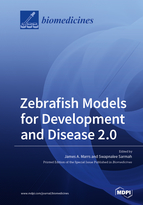Zebrafish Models for Development and Disease 2.0
A special issue of Biomedicines (ISSN 2227-9059). This special issue belongs to the section "Molecular and Translational Medicine".
Deadline for manuscript submissions: closed (31 December 2020) | Viewed by 39514
Special Issue Editors
Interests: zebrafish; fetal alcohol spectrum disorder; gastrulation; congenital heart defects; eye defects; cadherin; tight junction; adherens junction
Special Issues, Collections and Topics in MDPI journals
Interests: fetal alcohol spectrum disorder; congenital heart defects; zebrafish; craniofacial morphogenesis
Special Issues, Collections and Topics in MDPI journals
Special Issue Information
Dear Colleagues,
This Special Issue is the second volume of our previous Special Issue “Zebrafish Models for Development and Disease”. The zebrafish has become an important model organism to study normal development, particularly since large-scale genetic screening was used to identify genes that control developmental mechanisms. Subsequently, a large variety of creative approaches were used to develop disease models that are used to study developmental disorders, cancer, heart disease, diabetes, and many other conditions. The advent of next-generation DNA sequencing techniques expanded the utility of the zebrafish model, allowing analysis of genetic and epigenetic mechanisms of development and disease. Additionally, the small size, imaging capabilities, and reporter gene expression in the zebrafish permits high throughput toxicology evaluation and drug screening, increasing the capability of this model. The zebrafish is increasingly being used to study neurological, psychiatric, and behavioral conditions. This call for papers invites contributions of original research and reviews for this Special Issue of Biomedicines entitled “Zebrafish Models in Development and Disease”. The Special Issue will explore the diverse capabilities of the zebrafish model that can be applied to study a growing list of biological and preclinical research problems.
Scope:
- Basic research using the zebrafish model to understand diseases and mechanisms;
- Basic research using the zebrafish to model disease treatment strategies;
- Basic research using the zebrafish to evaluate potential teratogens;
- Basic research using the zebrafish for drug screening;
- Basic research using the zebrafish for neuroscience and behavioral studies;
- Review articles on describing any of the above topics using the zebrafish model organism.
Prof. James A. Marrs
Dr. Swapnalee Swapnalee Sarmah
Guest Editors
Manuscript Submission Information
Manuscripts should be submitted online at www.mdpi.com by registering and logging in to this website. Once you are registered, click here to go to the submission form. Manuscripts can be submitted until the deadline. All submissions that pass pre-check are peer-reviewed. Accepted papers will be published continuously in the journal (as soon as accepted) and will be listed together on the special issue website. Research articles, review articles as well as short communications are invited. For planned papers, a title and short abstract (about 100 words) can be sent to the Editorial Office for announcement on this website.
Submitted manuscripts should not have been published previously, nor be under consideration for publication elsewhere (except conference proceedings papers). All manuscripts are thoroughly refereed through a single-blind peer-review process. A guide for authors and other relevant information for submission of manuscripts is available on the Instructions for Authors page. Biomedicines is an international peer-reviewed open access monthly journal published by MDPI.
Please visit the Instructions for Authors page before submitting a manuscript. The Article Processing Charge (APC) for publication in this open access journal is 2600 CHF (Swiss Francs). Submitted papers should be well formatted and use good English. Authors may use MDPI's English editing service prior to publication or during author revisions.
Keywords
- disease model
- drug screening model
- teratogen screening
- toxicological screening
- neuroscience
- behavior
- developmental biology
Related Special Issues
- Zebrafish Models for Development and Disease in Biomedicines (5 articles)
- Zebrafish Models for Development and Disease 3.0 in Biomedicines (14 articles)








